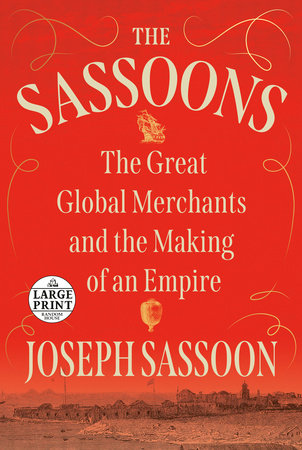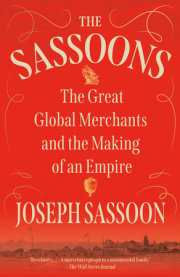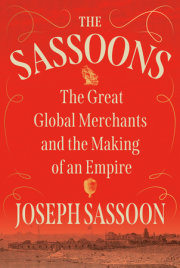PREFACE
It all began with a letter. Returning to my office from lunch one day during a fellowship at All Souls College, Oxford, in early 2012, I was greeted by a handwritten letter addressed to me on my desk, where it had been deposited by the college porter. The return address on the back of the envelope identified the sender as one Joseph Sassoon of Kirkcudbright, Scotland. I had never heard of the town and assumed it was a joke or a mistake of some kind. When I finally opened the letter, however, I found that its author was as described. My namesake had read an article of mine about authoritarian regimes in
Le Monde diplomatique. He thought it interesting enough, but what prompted him to write was our shared surname. He declared himself a descendant of Sheikh Sassoon ben Saleh Sassoon and believed I might be also, and therefore hoped to hear from me.
I had never been much interested in the history of the Sassoon family. As a child in Baghdad, I had ignored my father whenever he attempted to educate me about my illustrious forebears, going so far as to literally close my ears to annoy him. Later, when I had embarked on this project, there were many occasions when I wanted nothing more than to hear his tales and ask him a few questions for just a few minutes, but sadly the wish came two decades too late. All this is to say that the letter remained unanswered on my desk until my partner Helen heard about it, chastised me for my rudeness, and told me to write back. I did and suggested to this other Joseph Sassoon that we talk on the telephone, only to be mortified two days later when the porter proudly informed me that he had blocked what he thought was a prank phone call for me from a “Joseph Sassoon.” When I at last managed to speak to Joseph in Scotland, he told me about his father, the first cousin of the poet Siegfried Sassoon, and his grandfather, the husband of a prominent Gunzburg from Russia. Without his encouragement, I doubt this project would have taken off.
It was a subject with no relation to the book I had just finished, about the archives of Saddam Hussein’s Ba‘th Party, or the one that had brought me to Oxford, a comparative study of authoritarian systems in the Arab republics, but my appetite was whetted. I visited the National Archives at Kew and the British Library in London to read about the family, and traveled to Scotland to meet Joseph (known as Joey). He shared with me what he knew and the trove of pictures that had been passed down to him. He also referred me to Sybil Sassoon, another family historian and the creator of a comprehensive family tree, stretching back to 1830, that would prove immensely helpful—not least in distinguishing between other namesakes (unhelpfully for the researcher, the family favored just a few forenames, which recur within and across generations) and following individuals as they crossed continents in the age of empire, adapting their names as necessary.
I had no idea where these initial excursions would lead. Unlike Sybil, I was born too late to know any of the cast of this book, even the protagonists of the mid-twentieth century. And although I am descended from Sheikh Sassoon as Joseph hoped, he was the last ancestor we shared. When he fled Baghdad in 1830, fearing the wrath of the authorities, to join his oldest son, his other children remained in Baghdad. Some left Iraq later, but my ancestors stayed put until we too were forced to escape, for reasons similar to those of Sheikh Sassoon. After the Six-Day War in June 1967, life for the country’s Jews grew increasingly untenable. The rise of the Ba‘th Party a year later exacerbated the situation, and public hangings of Jews followed in 1969. When we finally managed to escape a couple of years later, we left with nothing except for a small bag, closing the door not only on our property but on a land where my family had lived for centuries. This book is thus intended to be not a family history but the history of a family, specifically a branch with which I can claim a connection but of which I am not, in the end, a member.
For me as a historian, what really tipped the balance was the discovery of a trove of untapped archival material. Sometime after reading slipped imperceptibly into research, I went to the National Library in Jerusalem, where most of the family’s archives are held. They contain thousands of documents dating from 1855 to 1949: everything from personal letters to account books and menus for dinner parties, seemingly every scrap of paper kept. The letters between family members tended to follow a similar structure: formal at the beginning and end of the letters; in the middle jumping from one subject to another; and often containing stinging criticism if trades had not been profitable or if one member of the family purchased a commodity at a price that another member considered too high. Most of this business correspondence was written in Baghdadi Jewish dialect to prevent outsiders from reading their letters; family members used their Baghdadi Jewish but wrote it in Hebrew characters (some refer to the language as Judeo-Arabic, but this is a relatively new term). The result is indecipherable to all but a few scholars, but fortunately I am fluent in Arabic, Hebrew, and the Baghdadi Jewish dialect. Writing this book, I felt sometimes as if the historian in me, the migrant, and the Baghdadi Jew were all jockeying for position. My hope is that, in the end, they coalesced and did not hinder me from investigating the history in an objective and unemotional manner.
Research in other archives in London, Delhi, Dallas, Shanghai, and Istanbul followed, and with the assistance of some wonderful archivists and researchers, I found much fascinating material produced by and about the family. Some years fell between archives, and for those I relied upon newspapers from China, India, England, the United States, and the Bahamas, and official documents of the relevant councils and chambers of commerce to fill in the gaps. The material grew vast—appropriately, given that the Sassoons straddled three empires: that of their adoptive home, Britain, and those of the two commodities whose trade they came to dominate, cotton and opium. Their legacy lay not only in dusty boxes in darkened storage rooms, however. Following the advice of Robert Caro, the great biographer of Lyndon Johnson, for historians to obtain a “sense of place,” I traveled to the Sassoons’ former residences in Mumbai, Pune, and the hill station of Mahabaleshwar; the synagogues they built in India and China; their headquarters in Shanghai; their estates in England; even their graves.
The geographical spread is telling. The Sassoons traded with members of seemingly every religion and sect around the globe, traveling extensively not only for business but to explore new horizons, and they felt at home wherever they settled, despite being a tiny minority in terms of both their religion and their migrant status. They were not unique in their time in amassing several fortunes and rising to the upper echelons of society. But unlike their more famous contemporaries, the Rothschilds and Vanderbilts, they bridged East and West. Their story is accordingly not just that of an Arab-Jewish family who settled in India, traded in China, and aspired to be British, but also a vista into the world in which they lived and prospered as well as its major developments—from the American Civil War to the Opium Wars, the opening of the Suez Canal and introduction of the telegraph as well as the mechanization of textile production. The era they inhabited was driven above all by an encompassing globalization, which they and other merchant families benefited from and influenced, and which shaped our current lives.
Unlike people in our fragmented world today, the Sassoons did not care about the ethnicity or religion of their counterparts; all they really cared about was one thing and one thing only: Could they trust them? This was not because they did not adhere to Judaism’s strict rules and traditions but because trust and reputation were the predominant characteristics that differentiated successful traders from others in a world where letters took three to five weeks to reach their destinations and even when the telegraph started, telegrams were expensive and traders were wary that their messages could be read by anyone. The Sassoons had relationships with traders across the world: from India to China to Persia to the Ottoman Empire, to Africa and Britain.
The Sassoons epitomized the way in which migration can influence different regions of the world. With their acumen and hard work, the founder and then the next two generations managed not only to enrich themselves but to contribute to the cities they were living in and to their communities. The Sassoons lived in three main hubs: Bombay, then Shanghai, and finally London. Their landmarks in those cities are still around today, particularly in Bombay (throughout the book, I use the city’s old name rather than Mumbai).
I begin in Ottoman Baghdad before the Sheikh’s departure and move with his son David Sassoon to Bombay, where he gradually built his business. Family was of immense importance to David, and he was blessed with one that was large by any standard. The book therefore necessarily focuses on the members who played leading roles in taking his business to its mercantile pinnacle, a truly global business distributed around the ports and cities of Asia, Europe, and the Middle East, trading not only cotton and opium but almost every major commodity, from tea and silk to spices and pearls, with a network of contacts and informants that was the envy of traders everywhere. Six personalities successively take center stage: David, the dynasty’s founder; his sons Abdallah (later Albert), who would succeed him on his death, Elias, who developed the business in China before setting off to create a rival one, and Suleiman, who managed the business in Asia after Albert’s attention was dragged to the West; Suleiman’s wife, Farha (later Flora), who took charge after his death and was, I believe, the first woman to run a global business in the nineteenth century; and finally Victor, who presided over the business in its last twenty-five years. They are joined by other Sassoons, not least the war-poet Siegfried, the politician and art collector Philip, and the first woman in Britain to be named editor at a national newspaper, Rachel Beer.
Less attractive to our eyes is the family’s involvement with one commodity that played a critical part in their success: opium. I have tried to understand this in its context, in light of the way the drug was perceived in their time, and to avoid passing moral judgment. I show instead how they came to control a large portion of the opium trade between India and China, how they ignored the winds of change around the world as its devastating effects became widely known, and how they used their political clout in Britain to delay prohibition.
This book traces not only the rise of the Sassoons but also their decline: why it happened, how the economic and political world order that had fostered their ascent began to change after the First World War, and how the realization of their aspiration to join the ranks of the British aristocracy drew their attention away from their business and prevented them from adapting to these new circumstances, leading to the winding up of their companies after the Second World War. In the annals of family histories, there are many such stories of incredible fortunes made and squandered over the course of four generations. None is more famous than
Buddenbrooks, Thomas Mann’s first novel. In it he charts with almost documentary precision the decline of a bourgeois family of German grain merchants over four generations in the middle of the nineteenth century. The Sassoons lacked the Buddenbrooks’ deep Hanseatic roots, however. As migrants, they had to establish themselves somewhere and ally themselves with some country. They chose Britain, the dominant world power at this book’s beginning but not at its end, and thus needed and wanted, probably more than anything else, to be accepted as English. They found success—Sassoons who had been born in Baghdad joined the English upper classes, befriending even royalty—but it was a metamorphosis as fatal to their fortunes as any misjudgment in Mann’s novel.
Copyright © 2022 by Joseph Sassoon. All rights reserved. No part of this excerpt may be reproduced or reprinted without permission in writing from the publisher.













